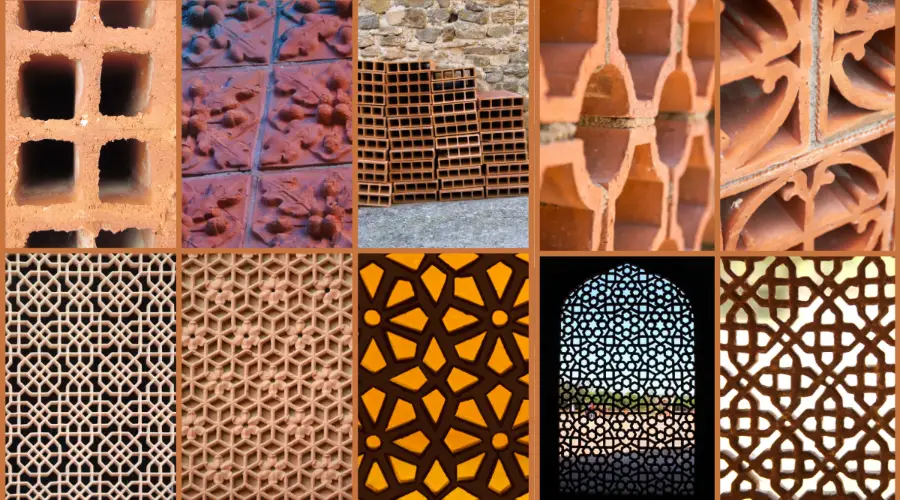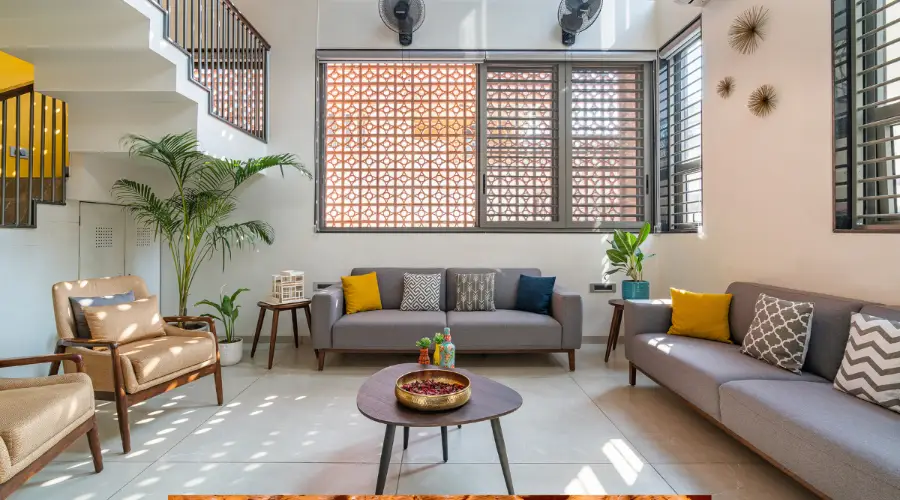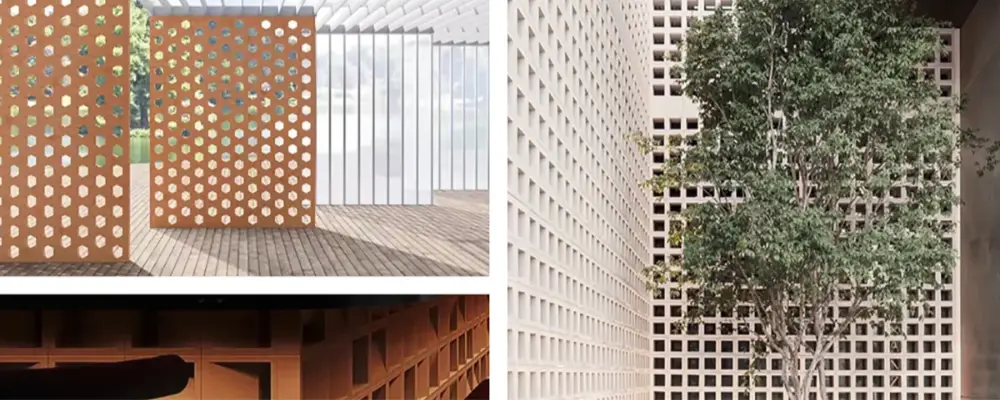In art and architecture, the use of terracotta jali bricks is prevalent around the globe. It has been a significant aspect of building materials in many ancient civilisations. With their distinctive, creative designs and outstanding performance, terracotta jali bricks stand out in the quest for modern architecture’s ideal fusion of aesthetics and functionality, giving your constructions an unmatched level of elegance and durability. More information regarding the functions, styles, uses, and characteristics of terracotta jali bricks will be provided to you here.
What is Terracotta Jali Brick?
Terracotta jali is also known as clay jali, which is purely made from red clay. They are available in floral patterns, geometric lines, and squares. The clay jalis will provide you with an earthy feeling. The clay jali looks cosy and invites the warm and comfortable sunlight into your home.
Types of Terracotta Jali Brick
Terracotta jali bricks are available in two major varieties.
- Solid Terracotta Jali Brick
Solid clay can be used to create thick, dense, and solid jali bricks. It is employed in the construction of massive structures and load-bearing walls.
- Hollow Terracotta Jali Brick
Because of their hollow core, these bricks weigh less. Additionally, the hollow form improves their insulation capabilities, aiding with soundproofing and temperature regulation. They are typically utilised for decorative components, non-load-bearing walls, and partitions.
Designs of Terracotta Jali Brick

The different designs of terracotta jali brick include four-petal, T.V. jali, sapphire jali, opel jali, amber jali, jade jali, camp jali, pearl jali, topaz jali, and diamond jali. Every company provides unique designs and offers specified features. They are also available in floral patterns, geometric lines, and squares. Robust foldable gates or movable dividers are made from terracotta jalis on metal frames. They give versatility and aesthetic appeal while blending style and functionality, making them easily incorporated into various architectural projects.
Applications of Terracotta Jali Bricks in Modern Architecture

For expansive areas that have subtle divides and transparent lighting, terracotta hollow window blocks are perfect. By acting as partitions, they produce a play of light and shadow and improve the perception of space. Terracotta bricks offer a blend of rich, rough, and delicate aesthetics for a flexible home style, adding texture and variation to interior design.
Example 1: To link and organise the area, use a terracotta screen block wall between the dining and living rooms.
Example 2: Terracotta bricks act as a wall between the living room and balcony, absorbing and dispersing light to create a cosy, gloomy atmosphere.
Properties of Terracotta Jali Bricks
Terracotta clay, which is used to make terracotta screen blocks, adds a natural, earthy feel and helps cool a space. These blocks are becoming more and more common in offices and households for several reasons:
Durability: Terracotta is long-lasting and doesn’t crack or scratch under strain. It is impervious to water, fire, erosion, and the growth of mould or bacteria. Low maintenance and repair expenses result from this.
Economical: Like other building materials, terracotta jali bricks are reasonably priced for their high availability. It is a good investment opportunity and provide a warm appearance.
Gorgeous Look: Terracotta’s rust, yellow, and orange shades lend a cosy, warm vibe to interior areas. It offers a wide range of design possibilities for different spaces because it can be moulded into different forms and patterns. For more variation, the surface can be painted.
Easy Maintenance: Because terracotta doesn’t absorb water, cleaning it with a moderate washing solution is simple. It is non-slip, low maintenance, and perfect for places like bathrooms.
Visual Effect: Beautiful shadow patterns can be produced by dividing huge areas with terracotta blocks that let light in. They are ideal for dividing spaces such as the dining and living rooms, balcony and family room.
Simple to Install: Installing terracotta jali walls is quick and easy, requiring only structural glue.
Durable Colour: Even when exposed to rain or sunlight, terracotta jali bricks will not deteriorate over time. After installation, they retain their colour for many years.
How to Install Terracotta Jaali Bricks?
Installation Advice:
- Use tile adhesive or cement mortar to install them like ordinary bricks.
- Use a stainless steel grid to hold the jaali blocks firmly in place for wider spans.
- Any colour can be used to paint jaalis, but first, use a primer to get a smooth finish.
These bricks offer privacy, ventilation, and sun protection while dividing spaces.
Where to Install Terracotta Jali’s for Better Use?
By letting in fresh air and filtered sunlight, they can change outdoor areas like balconies. They enhance the design’s elegance and work well for stair railings as well.
Jaalis are great as accent pieces in porches, kitchens, or at bar faces, or as ornamental partitions to divide spaces like dining and living areas.
Using jaalis in interior design creates an organic, earthy atmosphere.
Advantages of Terracotta Jaali bricks
- It is an environmentally sustainable cooling option because the natural clay material lowers indoor temperatures.
- Terracotta jalis, with their perforated designs, combine style and utility to create visually appealing screen systems.
- These jalis can improve the overall design in a variety of locations, including feature walls, railings, visual barriers, entrances, and facades.
- They give exterior designs a refined and aesthetically pleasing touch that makes buildings stand out.
- Terracotta jalis are durable and require little structural support because of their thickness, which guarantees both aesthetic appeal and usefulness.
Disadvantages of Terracotta Jaali Bricks
- Even though terracotta jaali bricks have more advantages, jali works come with some additional drawbacks. Customised jali works may require more craftsmanship, which can be more expensive.
- The complex patterns in jali may collect more dust than ordinary bricks. So, regular cleaning is required to maintain the appearance of the jali.
- The perforations in the jali may weaken the structural integrity of the wall if they are not supported properly.
- While it promotes ventilation and sunlight into your house, it cannot give much protection against heavy weather, like rain, which makes it unsuitable without waterproofing.
- Sealants must be used to protect the top layer of the jali bricks.
Conclusion
In conclusion, terracotta jaali bricks have their pros and cons, and the choice depends on the project’s needs. Terracotta jaalis are ideal for a traditional look and eco-friendly design. Terracotta jali bricks enhance decor while simultaneously facilitating light transmission, ventilation, and space separation. Light flowing through them creates patterns that give the surroundings unique effects.
FAQ’s
The characteristic earthy colour and texture of terracotta jalis are derived from clay that is burnt at high temperatures.
Terracotta jali has several drawbacks, such as being brittle and prone to breaking when struck, as well as possibly deteriorating over time if improperly cared for.
While letting light through, terracotta jali offers advantages like better air circulation, natural cooling, superior aesthetics, and more privacy.
Because of their resilience to weathering and moisture, terracotta bricks are a dependable long-term material that stands for many years.

